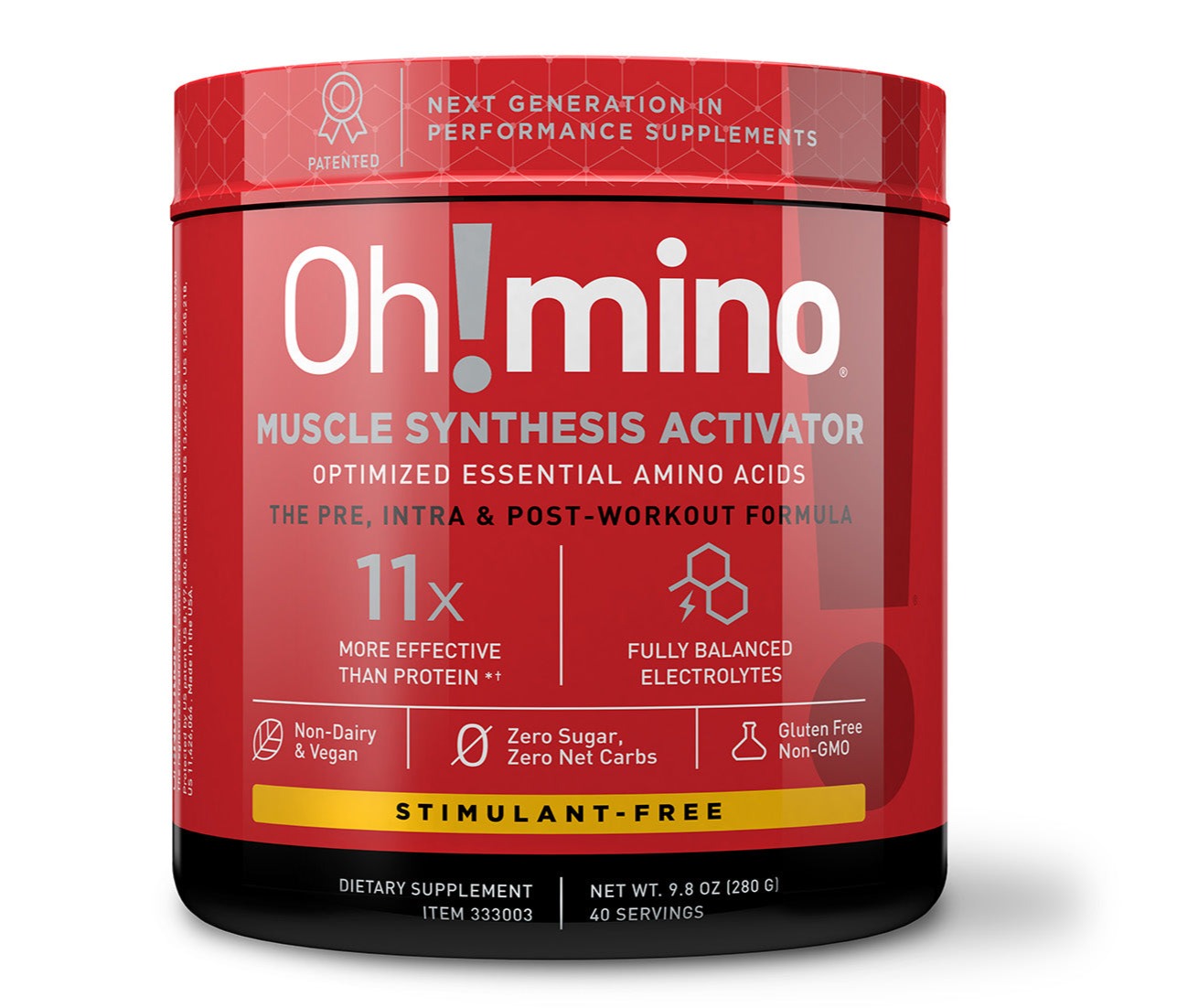Key Takeaways
-
Isometric exercises strengthen muscles by holding them in place, which increases tension and supports joints without any movement.
-
They’re great for boosting endurance and fixing muscle imbalances, helping you power through tough sticking points in your lifts.
-
You don’t need fancy equipment; these moves work anywhere, making them perfect for home workouts or travel.
-
Mixing isometrics with regular strength training levels up your results, building core strength, breaking plateaus, and improving total-body performance.
-
To get even more out of your workouts, Oh!mino® Muscle Synthesis Activator packs all nine essential amino acids (plus Glycine and adaptogens) in one clean, vegan formula. It’s designed to speed up recovery, support muscle growth, and keep you hydrated, perfect for any training routine.
What is Isometric Training?
Isometric training involves muscle contractions without the muscle or joint actually moving.
In contrast to dynamic movements like squats or bench presses, where muscles lengthen and shorten, isometric exercises involve static holds, where your muscles work to maintain a specific position under tension for an extended period.
Examples of isometric exercises include:
-
Planks
-
Wall sits
-
Isometric push-up holds
-
Glute bridges
-
Hand grips
While these movements appear simple, they challenge your muscles in ways that dynamic exercises can’t, building strength, endurance, and muscular control.
|
Oh!mino©: Elevate Your Performance. Accelerate Your Recovery. Science-Backed Superiority for Every Fitness Journey Power Your Goals with Proven Results:
The Oh!mino® Advantage: ✓ Patented formula that’s 11x more effective than protein, 20x more effective than BCAAs Choose Your Perfect Formula: Available in refreshing Tropical Slash or Berry Blast flavors, with stimulant-free or caffeinated options. Prefer capsules? We've got you covered with the same powerful formula. Take before, during, or after training—one solution for your entire workout. |
The Science Behind Isometric Training: Building Strength in Stillness
Here’s the “aha” moment: Isometric exercises maximize muscle activation without joint movement.
When you hold a position, your muscles remain engaged and contracted for a prolonged time, which increases muscle fiber recruitment.
While dynamic exercises tend to focus on the concentric (shortening) and eccentric (lengthening) phases of muscle contraction, isometric training holds the muscle in a fixed position, leading to a constant contraction that:
-
Increases time under tension (TUT), one of the key drivers of muscle growth and strength.
-
Improves joint stability and the strength of supporting muscles, reducing the risk of injury.
-
Enhances mind–muscle connection, helping you gain better control over muscle engagement.
The plank perfectly demonstrates isometric training in action, where holding this static position engages and contracts your core muscles for maximum activation without any joint movement
The Benefits of Isometric Training
Improved Strength and Muscle Endurance
Isometric training is highly effective for increasing strength in a specific range of motion.
By holding positions under tension, your muscles work harder to maintain stability and control.
This increases overall muscle endurance and helps build strength in areas where you may have weaknesses or imbalances.
For instance, if you’re struggling to complete the final reps of a pull-up, holding an isometric contraction at the top of the movement can build strength in the upper range of motion, ultimately helping you improve your performance over time.
Joint Stability and Injury Prevention
Isometric exercises train not just your muscles but also the connective tissues around your joints.
When you hold a position, you’re engaging smaller stabilizing muscles that are often neglected in traditional dynamic movements.
Over time, this builds better joint stability, making you more resilient and reducing the risk of injury, especially in areas like the knees, shoulders, and hips.
Rehabilitation and Recovery
Isometric training is often used in rehabilitation settings because it allows you to build or maintain strength without placing stress on injured or recovering joints.
For example, if you’re recovering from a knee or shoulder injury, isometric exercises like wall sits or isometric shoulder presses can keep the muscles strong and engaged while avoiding unnecessary strain on the joint.
Maximizing Muscle Engagement
One of the key benefits of isometric training is how effectively it enhances muscle recruitment.
During an isometric hold, your body engages multiple muscle fibers to maintain the position, helping you build strength and improve endurance even in muscle groups that might not get much attention during dynamic exercises. Over time, this leads to greater overall muscular control and balance.
Minimal Equipment, Maximum Results
Another great aspect of isometric training is its accessibility. Many isometric exercises require little to no equipment, making it an excellent option for home workouts, travel, or situations where gym access is limited. A wall, a chair, or your own body weight is often all you need to build strength using isometric training.
How Isometric Training Enhances Other Strength-Building Strategies
Isometric exercises can be integrated into your existing fitness routine to enhance your overall strength-building strategy. Here’s how:
Breaking Through Strength Plateaus
If you’ve hit a plateau in your weightlifting or strength training program, isometric exercises can help you break through. By holding challenging positions, like the midpoint of a squat or deadlift, you can build strength in those specific ranges of motion, allowing you to lift heavier weights over time.
Building Core Strength and Stability
Isometric exercises are particularly effective for building core strength and stability. Movements like planks, side planks, and hollow holds engage the deep core muscles, which are responsible for maintaining stability and balance during dynamic movements. A stronger core enhances your performance in almost every exercise, from squats to push-ups to running.
Enhancing Functional Fitness
Functional fitness relies on your ability to move efficiently through everyday activities, which requires not just muscle strength but also joint stability and control. Isometric exercises improve your ability to maintain tension in real-life situations, like carrying groceries, lifting objects, or holding a heavy bag, helping you move through your day with more ease and less risk of injury.
Real-life activities like carrying multiple boxes demonstrate exactly why functional fitness matters, and how isometric training helps you maintain control and stability during everyday tasks.
Isometric Training for Strength and Conditioning
Integrating isometric exercises into your workout routine doesn’t require an overhaul of your existing program. Here are a few ways to add isometric exercises to your strength and conditioning workouts:
1. Isometric Holds as Finishers
One of the easiest ways to incorporate isometric training is to add it at the end of your workout as a finisher. For example:
-
After your leg workout, perform a wall sit for 60 seconds to challenge your quads, glutes, and core.
-
Following your upper-body routine, hold an isometric push-up at the halfway point for 30 seconds to build chest, shoulder, and triceps strength.
2. Pair Isometric Holds with Dynamic Movements
Another effective strategy is pairing isometric exercises with dynamic movements in a superset. For example:
-
Perform a set of lunges, then immediately follow with a split squat hold for 30 seconds.
-
Do a set of pull-ups, then finish with a chin-up hold at the top position for maximum strength engagement.
3. Isometric Circuits
Create a full workout by stringing together a series of isometric exercises, targeting multiple muscle groups:
-
Plank hold (core) – 60 seconds
-
Wall sit (legs) – 45 seconds
-
Push-up hold (upper body) – 30 seconds
-
Glute bridge hold (glutes) – 60 seconds
-
Rest for 1 minute, then repeat 3–4 times.
How Oh!mino® Enhances Your Isometric Training
Getting the most out of your isometric training means supporting your muscles with the right fuel. Our Muscle Synthesis Activator is designed to enhance muscle repair and growth, making it the perfect complement to your strength-building efforts.
Oh!mino's Muscle Synthesis Activator provides the essential fuel your muscles need during isometric training!
Isometric holds place significant tension on your muscles, and Oh!mino® helps accelerate recovery by delivering exactly what your body needs to rebuild and grow stronger. Our science-backed formula features all 9 essential amino acids in the ideal sequence: L-Leucine, L-Lysine, L-Threonine, L-Valine, L-Phenylalanine, L-Histidine, L-Isoleucine, L-Tryptophan, and L-Methionine. These work together far more efficiently than BCAAs alone or standard protein powders, and we've also included Glycine, the semi-essential amino acid, plus potent adaptogens to support your body's stress resilience and cellular health.
What makes it especially valuable for isometric training is how we support your entire system during those challenging holds. Our carefully balanced electrolytes ensure your body remains hydrated and primed for peak performance, while our formula delivers sustained, jitter-free energy without the crashes common with other supplements.
We've created something completely clean and vegan; it’s dairy-free, gluten-free, zero sugar, and zero carbs, with no artificial flavors, fillers, or unnecessary additives. You get pure, effective nutrition that aligns with your values.
Using our Muscle Synthesis Activator couldn't be simpler. Just mix 1 to 2 scoops with 8 to 12 ounces of water or juice at any point in your workout routine. It fits easily into your day, fueling your muscles exactly when they need it most.
Try Oh!mino® Muscle Synthesis Activator today!
Frequently Asked Questions (FAQ)
What exactly are isometric exercises?
Isometric exercises are strength-training movements where the muscles contract and generate force but the joints themselves stay still, and the muscles don't change length. Examples include planks, wall sits, and static lunges.
How long should I hold an isometric position?
The ideal duration varies with fitness level and training goals. Most isometric holds are performed for 10–60 seconds, but beginners may start with shorter holds and progress over time to longer or more intense contractions.
Are isometric exercises enough for overall fitness?
Isometric exercises build strength and stability but mainly at the angle at which you hold the contraction. For complete muscle development and functional fitness, they are best integrated alongside dynamic (moving) exercises in a balanced program.
Can isometric exercises build muscle mass?
Isometric training does increase muscle strength and can stimulate some hypertrophy (muscle growth), especially when performed at high intensity. However, for maximum muscle size, combining isometrics with dynamic weight training is recommended.
How do I use Oh!mino® Muscle Synthesis Activator?
Simply mix 1–2 scoops of our Oh!mino® Muscle Synthesis Activator with 8–12 oz of water or your favorite juice. It can be used before, during, or after your workout for optimal muscle support and hydration.




